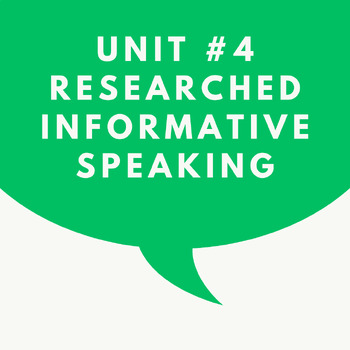Unit #4: Researched Informative Speech - Oral Communication or Speech
Ms Flanagan Says
5 Followers
Grade Levels
9th - 12th
Subjects
Resource Type
Standards
CCSSW.9-10.2
CCSSW.9-10.2a
CCSSW.9-10.2b
CCSSW.9-10.2c
CCSSW.9-10.2d
Formats Included
- Google Drive™ folder
Ms Flanagan Says
5 Followers

Made for Google Drive™
This resource can be used by students on Google Drive or Google Classroom. To access this resource, you’ll need to allow TPT to add it to your Google Drive. See our FAQ and Privacy Policy for more information.
Also included in
- This bundle is an entire, semester-long course of an oral communication or speech class. The 5 units of varying lengths each end in a student-generated and delivered speech, culminating in a group speech for charity at the end. Unit #1: Communication ProcessUnit #2: Stage Fright and Speech PreparatiPrice $35.10Original Price $39.00Save $3.90
Description
This folder has everything you need to conduct a unit on writing a researched informative speech.
- Unit #4 Lecture Slides (Lesson #1 in Preview)
- Unit #4 Guided Notes
- Unit #4 Review: “Um Actually…”
- Group Topic Brainstorm Sheet
- Researched Informative Speech Rubric
- Speech Peer Review Doc
Total Pages
Answer Key
N/A
Teaching Duration
3 Weeks
Report this resource to TPT
Reported resources will be reviewed by our team. Report this resource to let us know if this resource violates TPT’s content guidelines.
Standards
to see state-specific standards (only available in the US).
CCSSW.9-10.2
Write informative/explanatory texts to examine and convey complex ideas, concepts, and information clearly and accurately through the effective selection, organization, and analysis of content.
CCSSW.9-10.2a
Introduce a topic; organize complex ideas, concepts, and information to make important connections and distinctions; include formatting (e.g., headings), graphics (e.g., figures, tables), and multimedia when useful to aiding comprehension.
CCSSW.9-10.2b
Develop the topic with well-chosen, relevant, and sufficient facts, extended definitions, concrete details, quotations, or other information and examples appropriate to the audience’s knowledge of the topic.
CCSSW.9-10.2c
Use appropriate and varied transitions to link the major sections of the text, create cohesion, and clarify the relationships among complex ideas and concepts.
CCSSW.9-10.2d
Use precise language and domain-specific vocabulary to manage the complexity of the topic.



